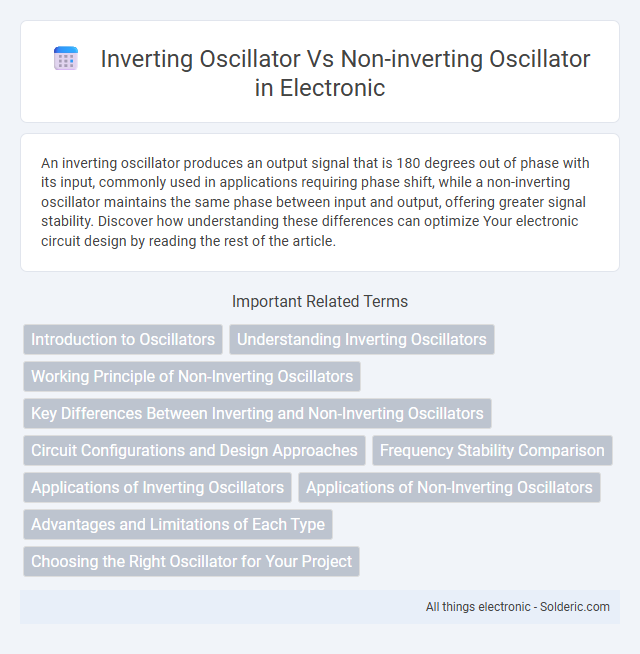An inverting oscillator produces an output signal that is 180 degrees out of phase with its input, commonly used in applications requiring phase shift, while a non-inverting oscillator maintains the same phase between input and output, offering greater signal stability. Discover how understanding these differences can optimize Your electronic circuit design by reading the rest of the article.
Comparison Table
| Feature | Inverting Oscillator | Non-inverting Oscillator |
|---|---|---|
| Operation | Uses an inverting amplifier for feedback | Uses a non-inverting amplifier for feedback |
| Phase Shift | 180deg phase shift provided by the amplifier | 0deg phase shift by the amplifier |
| Feedback Type | Negative feedback with phase inversion | Positive feedback without phase inversion |
| Common Circuit Examples | Phase-shift oscillator, Wien-bridge oscillator (with inverter) | Wien-bridge oscillator, Colpitts oscillator |
| Frequency Stability | Good frequency stability with proper RC network | High frequency stability in some designs |
| Output Waveform | Sine wave or triangle wave depending on circuit | Sine wave mostly |
| Gain Requirement | Loop gain >= 1 with phase inversion | Loop gain >= 1 without phase inversion |
| Applications | Signal generators, audio oscillators | RF oscillators, audio oscillators |
Introduction to Oscillators
Oscillators generate periodic signals essential for clock generation, communication systems, and signal processing. Inverting oscillators use an active device's inversion property with feedback to produce oscillation, typically involving an operational amplifier or transistor in an inverting configuration. Non-inverting oscillators maintain phase through the feedback network and active device, enabling stable sinewave or squarewave outputs without signal inversion.
Understanding Inverting Oscillators
Inverting oscillators utilize feedback that inverts the phase of the signal, typically using an operational amplifier or transistor configured to produce a 180-degree phase shift, essential for sustaining oscillations. This phase inversion combined with the feedback network's frequency-selective components ensures the loop gain reaches unity at the desired oscillation frequency. Key examples include the Wien bridge and phase-shift oscillators, where precise component values control frequency stability and waveform purity.
Working Principle of Non-Inverting Oscillators
Non-inverting oscillators generate continuous waveforms by feeding the output signal back to the input without phase inversion, maintaining the same polarity throughout the feedback loop. They operate on the Barkhausen criteria, where the loop gain equals unity and the total phase shift around the loop is zero degrees, ensuring sustained oscillations. Common circuits like the Wien bridge oscillator utilize this principle to produce stable sinusoidal signals with low distortion and high frequency stability.
Key Differences Between Inverting and Non-Inverting Oscillators
Inverting oscillators produce an output signal that is 180 degrees out of phase with the input, whereas non-inverting oscillators maintain the same phase between input and output. The feedback in inverting oscillators is negative through the inverting terminal, essential for oscillation, while non-inverting oscillators use positive feedback via the non-inverting terminal. Understanding these phase and feedback differences helps you select the right oscillator type for your electronic circuit's stability and signal requirements.
Circuit Configurations and Design Approaches
Inverting oscillators use feedback configurations where the output is phase-shifted by 180 degrees and fed back into the inverting input, ensuring the total phase shift meets the Barkhausen criterion for oscillation. Non-inverting oscillators feed the output back to the non-inverting input, providing zero phase shift, often implemented with positive feedback loops for stable sine-wave generation. Your choice between these oscillators depends on the required phase relationship, frequency stability, and complexity of the oscillator design approach.
Frequency Stability Comparison
Inverting oscillators generally offer moderate frequency stability due to phase inversion requirements and feedback network sensitivity, which can introduce phase noise and slight variations. Non-inverting oscillators provide superior frequency stability by maintaining consistent phase conditions and typically incorporating positive feedback with less phase disruption, resulting in stable amplitude and frequency output. The choice between these oscillators depends on the application's tolerance for frequency drift and the precision of feedback components used.
Applications of Inverting Oscillators
Inverting oscillators are widely used in signal processing applications requiring phase inversion, such as waveform generation, phase-locked loops, and frequency modulation systems. Their ability to provide a 180-degree phase shift makes them essential in sinusoidal oscillators like the Wien bridge and phase-shift oscillators. These oscillators are also critical in communication circuits where stable oscillation and precise frequency control are crucial for modulation and demodulation processes.
Applications of Non-Inverting Oscillators
Non-inverting oscillators are widely used in applications requiring stable frequency generation, such as signal generation in communication systems and clock pulses in digital circuits. Their ability to produce a consistent amplitude output without phase inversion makes them ideal for audio frequency synthesizers and waveform generators. Your electronic design can benefit from non-inverting oscillators when precision and signal integrity are crucial.
Advantages and Limitations of Each Type
Inverting oscillators offer advantages such as simpler circuit design and ease of achieving phase shift required for oscillation, making them suitable for generating stable sine waves in audio applications; however, they may require precise component matching and can suffer from limited frequency range. Non-inverting oscillators provide higher input impedance and better signal buffering, which enhances stability and reduces signal distortion, but they often involve more complex circuitry and can have increased power consumption. Your choice depends on the desired frequency stability, signal purity, and circuit complexity constraints in your specific application.
Choosing the Right Oscillator for Your Project
Inverting oscillators are ideal for applications requiring phase inversion and are commonly used in audio signal generation and waveform shaping due to their simple design and stable frequency output. Non-inverting oscillators excel in applications demanding low distortion and higher input impedance, making them suitable for precise timing circuits and sensor signal processing. Selecting the right oscillator hinges on factors such as desired waveform stability, signal phase requirements, and load driving capabilities to ensure optimal performance in your electronic project.
Inverting oscillator vs Non-inverting oscillator Infographic

 solderic.com
solderic.com